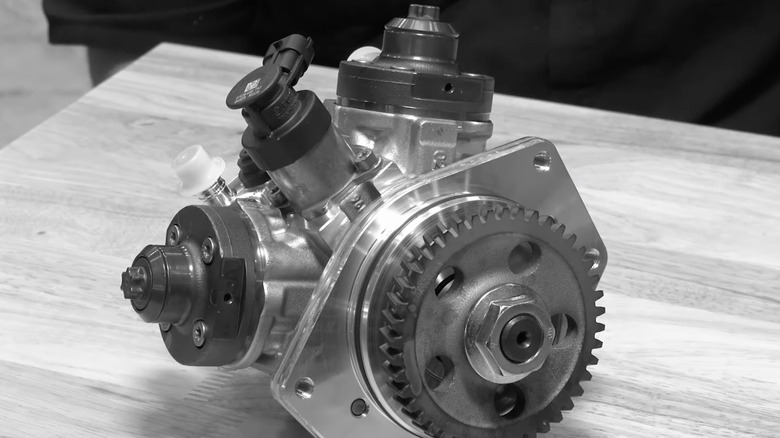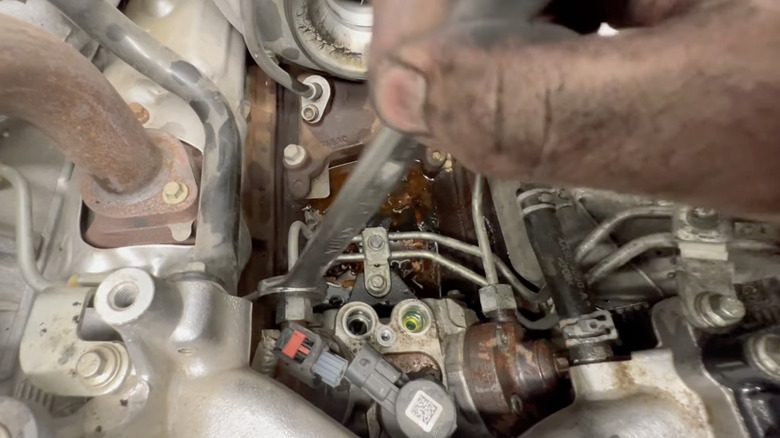How To Tell If Your Truck Has A CP4 Fuel Pump
If you browse forums often, chances are you've come across some heated discussions around the CP4 fuel pump. The CP4, short for "Common Rail Pump 4," is a high-pressure fuel injection pump that made its way into Ford and GM diesel trucks starting in 2011. It was intended as a next-gen replacement for the tried-and-true CP3 pump, which had built a reputation for rock-solid reliability. Unfortunately, it didn't quite follow in its predecessor's footsteps.
The CP4 was originally engineered to deliver diesel fuel at pressures exceeding 30,000 psi, shooting it into the common rail and ultimately through the injectors with precision timing. Now, this sounds great on paper, but real-world results have been far less inspiring.
That's because modern ultra-low sulfur diesel doesn't provide enough lubrication. This, when paired with the CP4's flawed internal design, creates excessive friction between the pump's moving metal parts. Over time, this friction causes tiny metal shavings to break off inside the pump. These shavings then travel through the fuel system, where they can severely damage critical components like the injectors, fuel rails, and high-pressure lines.
Once failure strikes, repairs can top $10,000 if you're out of warranty. So, you might want to know if your truck has this problematic pump to know what you've gotten yourself into.
Locating and recognizing a CP4
A quick peek under the hood will help clear things up, assuming you know what you're looking for. On Ford's 6.7L Powerstroke engines (2011–2024), the CP4 pump is situated near the engine, directly across from the turbo. GM Duramax trucks (2011–2016) with LML or LGH engines have it tucked in the front of the engine valley, just behind the water pump. If you're driving a Ram with a 6.7L Cummins engine from the brief 2019–2020 CP4 era, the pump is located on the front cover, opposite the gear train.
Visually, the CP4 is a compact, gray or black unit. You can trace the high-pressure fuel lines from the fuel rail back to it. A tell-tale sign is the attached metering unit — also called the FCA (fuel control actuator) — which sometimes includes a screen.
If you're still unsure, look for identifying marks or part numbers on the housing. Some revised CP4 units have a dimple to signal an updated design. Of course, the most foolproof way to confirm your pump type is by checking your VIN, owner's manual, or digging through manufacturer specs based on your truck's year and model. Online forums and dealer databases can also help.
You've got a CP4 pump — now what?
If you've confirmed your truck has a CP4, it's worth taking a few proactive steps. First off, understanding why this matters isn't just about being informed — it's about protecting your wallet. As mentioned above, the pump has a reputation for sudden catastrophic failure. These failures often occur without much warning and can start as early as 10,000 miles, despite claims of a 100,000-mile lifespan.
For owners, this means tighter maintenance routines. Use only clean diesel from trusted stations, consider adding lubricity additives at every fill-up, and replace fuel filters every 15,000 miles. Never let the tank run too low, as doing so deprives the pump of lubrication. Also, keep an eye on fuel economy, misfires, and especially metal shavings in the metering unit screen. If you're out of warranty, a CP4 failure can mean replacing not just the pump, but also the entire fuel system — injectors, rails, lines, and all.
Some owners go as far as preemptively swapping their CP4 for a CP3 conversion kit. It's not cheap, but it's often cheaper than the price tag of a full fuel system overhaul after a failure.


